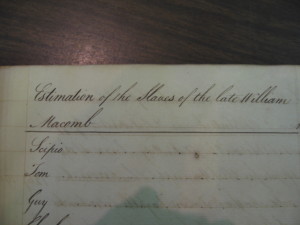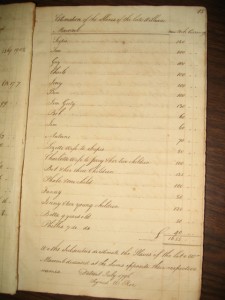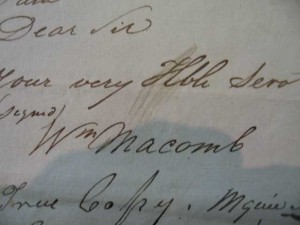
- Inventory of slaves in Detroit, Michigan. Joel Thurtell photo of record in Burton Historical Collection, Detroit Public Library
By Joel Thurtell
Just as I predicted in a January 2007 Detroit Free Press story, Grosse Ile’s historians changed history.
But not the way I expected.
Early in 2007 (I retired from my Free Press reporting job the following November), the people who manage historical perceptions on the Big Island led me to believe that they were going to include the slavery aspect of their community’s past in a book they were preparing about Grosse Ile history.
Instead of publishing the facts, they chose to censor.
In Part II of my series, “Tomatoes & Eggs,” I’ll reproduce my review of the Grosse Ile Historical Society’s book.
And I’ll explain “Tomatoes & Eggs.”
With permission from the Detroit Free Press, here is the first installment of a series about local control of history.
Headline: HISTORY TELLS TALE OF SLAVES ON GROSSE ILE
Sub-Head: BUT MANY DETAILS ARE STILL A MYSTERY
Byline: BY JOEL THURTELL FREE PRESS STAFF WRITER
Pub-Date: 1/21/2007
Memo: DOWNRIVER
Correction:
Text: On Grosse Ile, they’re changing history.
Or at least they’re changing the way it’s written.
They plan to mention that black and American Indian slaves once lived
on the island.
Sarah Lawrence and Ann Bevak are working on the Grosse Ile Historical
Society book, and this information wasn’t on their radar.
Now it is.
Lawrence is editing the book, and Bevak is working on the early
history chapter.
Once I shared the results of my research with Bevak, she grasped the
possibilities, like reproducing the 1796 price list of slaves.
“It’s the kind of thing people will latch onto,” she said.
They aren’t the only Grosse Ile folks who are only now hearing about
this, even though human chattels were a part of daily life on Grosse
Ile for sure before 1796, and maybe later. That’s the year Britain
turned Michigan over to the fledgling United States. It’s also when
the largest holder of slaves in Michigan died.
After the death of William Macomb, his heirs itemized all his
property – cows and horses, copper fish kettles, a beehive, a pair of
saddlebags and 26 slaves.
Twenty years earlier, William Macomb and his brother, Alexander
Macomb, bought Grosse Ile from Indians. I wrote about the Macomb
(pronounced Macoom) brothers a couple of years ago and got an e-mail
from Bill McGraw, a fellow Free Press reporter, who wondered if I knew
that William Macomb had been a slave-owner.
I didn’t.
At that point, McGraw contended that historians have written little or
nothing about this aspect of Michigan history.
Seems he’s right.
The Macomb brothers have descendants on Grosse Ile, and they didn’t
know about it. The brothers were the
great-great-great-great-grandfathers of Connie de Beausset. (Two of
the brothers’ children, who were first cousins, married and de
Beausset is their descendant.) Her family owns the oldest working
farm in Michigan to stay in one family; the farm specializes in
azaleas and rhododendrons.
“No, I can’t be any help to you at all on that,” Connie de Beausset
told me. “I haven’t heard anything about any slaves.”
Her daughter, who runs the family’s Westcroft Gardens, was surprised too.
“No, I wasn’t aware of them having slaves at all,” said Denise de
Beausset. “That’s funny; you’d think there would have been talk about
slaves running the farm. Nobody ever talks about it on our side. I
wonder if it was out of embarrassment or it wasn’t politically
correct. Nobody ever talked about slaves.
“I’ll be darned.”
I found the inventory of William Macomb’s property in the Detroit
Public Library’s Burton Historical Collection. The list is quite long,
and includes two oxen valued at 24 New York pounds; four cows, 40
pounds; a pair of andirons, 4 pounds, and a stovepipe, 25 pounds.
It has an “Estimation of the Slaves of the late William Macomb.” Most
esteemed were two slaves named Scipio and Jim Girty, each valued at
130 New York pounds. Ben was worth 100 pounds. Bel was priced at 135
pounds, but that included her three kids. Bob was worth 60 pounds.
Phillis was worth 40 pounds, though she was only 7 days old.
Jerry was valued at 100 pounds and his wife, Charlotte, with her two
children, was priced at 100 pounds.
But here’s the interesting thing about Charlotte: In 1793 and 1794,
the Macomb house on Grosse Ile was “in charge of Charlotte,” wrote
Isabella Swan in “Deep Roots,” her history of Grosse Ile. “Charlotte
had been with the Macombs as early as 1788,” wrote Swan.
Charlotte was boss of the farm, but still, after her owner’s death,
she was cataloged along with William Macomb’s 25 other human pieces of
property.
“I’ve never heard that name Charlotte,” Connie de Beausset told me.
What happened to Charlotte and the other 25 Macomb slaves? Letters in
the Burton Collection, written by William Macomb before his death,
show that he was in the habit of buying and selling slaves.
On Jan. 12, 1790, Macomb acknowledges partial payment for “a negro wench.”
He wrote on Aug. 17, 1789, that “I have taken the liberty to address
to your care Two negroes a Woman & a man the property of Mr. Alexis
Masonville. They are to be disposed of at your place for 200 pounds
New York currency. I cannot say much in their favor as to honesty,
more particularly of the woman she is very handy & a very good cook.
The man is a very smart active fellow & by no means a bad slave.
“I hope you may be able to dispose of them at your place & remit to me
the money. I do not wish they should be dispose of to any person
doubtful or on a longer credit than the first of June next – I am Dear
sir your very Able servant Wm Macomb.”
The Ordinance of 1787 banned slavery in the new territories that would
become Ohio, Indiana, Illinois and Michigan. But slaves belonging to
British settlers were still allowed. The 1810 census showed 17 slaves
still in Detroit, according to the American Legal History Network Web
site www.geocities.com/michhist/detroitslave.html?20079, and in 1818,
the Wayne County assessor was still taxing slaves as property.
On Grosse Ile, African Americans weren’t the only slaves. According to
Swan, there may have been an enslaved Indian on the island about 1795.
“The Indians who were slaves had been taken captive in inter-tribal
wars and sold to the whites. Those who held slaves when the Americans
took over were allowed to retain them,” wrote Willis Dunbar in
“Michigan: A History of the Wolverine State.”
With historical documents and publications to refer to, the Grosse Ile historians can use
the information about slavery in their book, to be published by Arcadia Publishing in
Chicago.
“I think that would be a good part for the book,” said Denise de
Beausset “That’s a really big part of the history of the island, that
it’s not just the rich and famous that moved here later.”
Great. Now I have another assignment for you Grosse Ile historians.
Under “slaves” in the index of Isabella Swan’s book there’s a
reference to pages 37-38: “Ben and Dan escape.”
Well, Ben and Dan made such a clean getaway that I can’t find mention
of them on either of those pages. Can somebody tell me the story of
those fugitive slaves, Ben and Dan?
Caption: 2005 photo by MARY SCHROEDER / Detroit Free Press
Connie de Beausset holds a copy of the treaty that the Macombs and the
Indians signed giving the Macombs the right to Grosse Ile. Although de
Beausset is a descendant of the Macombs, neither she nor her daughter,
Denise de Beausset, had known of the existence of family slaves.
JOEL THURTELL / Detroit Free Press
William Macomb’s signature on a letter relating to the sale of two slaves.
JOEL THURTELL / Detroit Free Press
“Estimation of the Slaves of the late William Macomb,” from the
inventory of Macomb’s property.
2005 photo by KATHLEEN GALLIGAN / Detroit Free Press
A Historical Commission marker stands on the Grosse Ile site of the
state’s oldest continuously working farm. Its owners are descendants
of William Macomb.
Illustration: PHOTO
Edition: METRO FINAL
Section: CFP; COMMUNITY FREE PRESS
Page: 1CV
Keywords: michigan history
Disclaimer: THIS ELECTRONIC VERSION MAY DIFFER SLIGHTLY FROM THE
PRINTED ARTICLE

